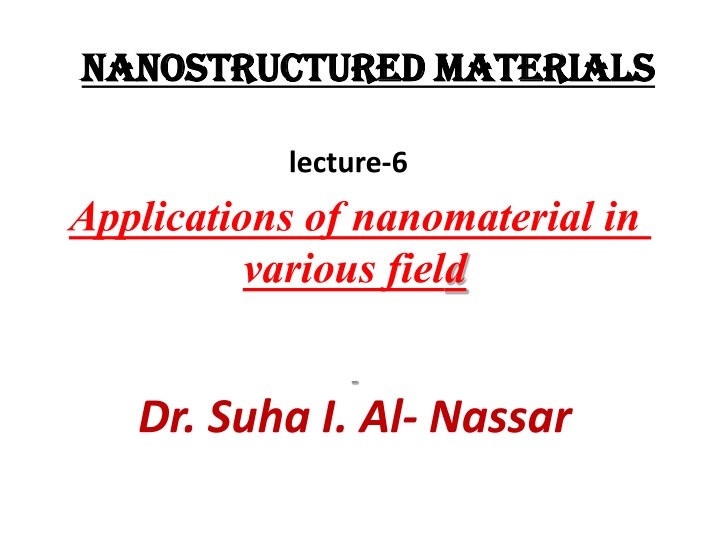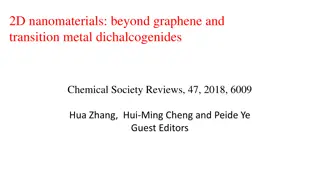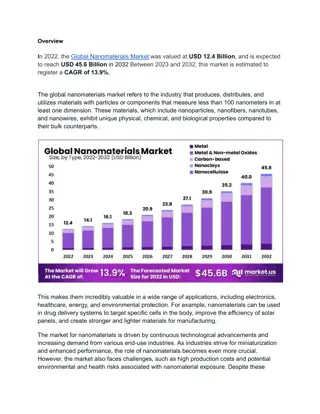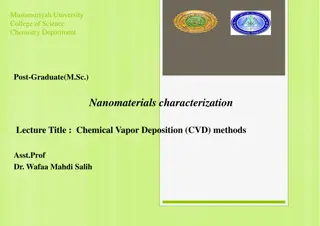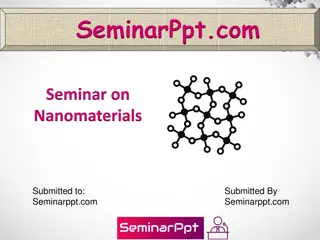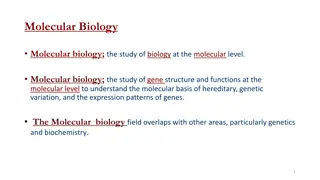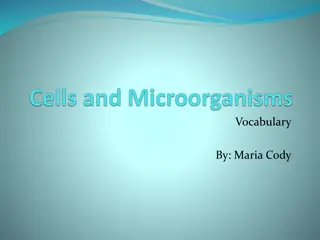Applications of Nanomaterials in Medicine and Biology
Nanomaterials play a crucial role in medicine by serving as drug carriers, bioimaging agents, and therapeutic entities due to their unique properties. In biology, nanotechnology is used for tissue regeneration, biomarker identification, and bioimaging of pathological lesions. The applications of nanomaterials in medicine and biology lead to advancements in cancer therapy, cardiovascular diseases, neurological diseases, and more.
Download Presentation

Please find below an Image/Link to download the presentation.
The content on the website is provided AS IS for your information and personal use only. It may not be sold, licensed, or shared on other websites without obtaining consent from the author.If you encounter any issues during the download, it is possible that the publisher has removed the file from their server.
You are allowed to download the files provided on this website for personal or commercial use, subject to the condition that they are used lawfully. All files are the property of their respective owners.
The content on the website is provided AS IS for your information and personal use only. It may not be sold, licensed, or shared on other websites without obtaining consent from the author.
E N D
Presentation Transcript
Nanostructured Materials Nanostructured Materials lecture-6 Applications of nanomaterial in various field Dr. Suha I. Al- Nassar
Introduction Nanomaterials having a wide range of applications in the field of electronics, fuel cells, batteries, agriculture, food industry, and medicines, etc... It is evident that nanomaterials split their conventional counterparts because of their superior chemical, physical, and mechanical properties and of their exceptional formability. The range of commercial applications of nanotechnology is vast and overgrowing, but the following areas could be regarded as particularly important.
1-Medicine applications Due to their small sizes, surface area modification capacity and unique biological properties, nanomaterials have a broad scope of application in medicine, pharmacy and medical diagnostics. Those structures are used. as carriers for drug substances, in magnetic and fluorescent bioimaging, as elements of measuring sensors, and sometimes they exhibit therapeutic activity themselves (antimicrobial activity). Given their properties, significantly different from the matter that surrounds us, the nanomaterials are still and intriguing and mysterious subject. Proper use of the knowledge on those structures and the ability to put them to practical use in treatment, diagnostics and disease prevention will benefit the health and quality of life. Nanotechnology is applied to medicine and related sciences such as in the rapidly developing research on the therapy of cancer, cell bioimaging, targeted therapy, drug delivery on the cellular level, and in the regeneration of tissues and organs.
Figure (1) explains pharmacy and medical diagnostics. It should be pointed out that contribution to the development of each of the fields presented below takes place simultaneously, whereby mutual impact and complementation of those fields should also be considered outlines the practical application of nanotechnology to medicine, nanotechnology s
In Biological field Biological materials and systems exhibit complex functionality and are composed of nanoscale components. Nature combines hard and soft materials, often in hierarchical architectures, to get synergistic, combinations of properties. Those structures are used in the imaging of pathological lesions of tissues and organs, biomarker identification or tissue regeneration. The latest developments in nanotechnological engineering are applied to the therapy of conditions including: cancers, cardiovascular diseases, neurological diseases and more . Bioimaging of tissues and organs usually involves quantum dots and nanoparticles. The necessary condition of bioimaging is the functionalization of the nanostructure with an appropriate ligand, specific for the receptor of bioimaged cells. Certain optical properties of the nanomaterial (e.g. fluorescence) make certain cell or tissue areas visible when exposed to radiation at excitation wavelength .Compared to traditional dyes used in bioimaging (rhodamine, fluoroscein), quantum dots are characterized by higher photostability, wide absorption band, narrow and symmetrical band of fluorescence emission, high quantum efficiency of fluorescence and long fluorescence lifetime optimized properties and
Drug Delivery field Another field of application for nanostructures is the drug delivery on cellular level. This method of active substance administration improves the pharmacokinetic properties of the drug, which translates into better dissolution kinetics, quicker absorption and achieving the therapeutic concentration in the target tissue . One of the known methods of ensuring a therapeutic effect combined with simultaneous control of the therapeutic process through monitoring the fluorescence (bioimaging) is the coupling of anti-cancer drugs with quantum dots. Certain nanomaterials may function as the internal scaffold for the damaged tissues, facilitating their regeneration. In the case of bone structure regeneration those materials, aside from providing support, may also function as the carriers for the drug substance .Traditional materials used in regenerative medicine have a limited durability, caused by inflammation occurring around the implant, infection or osteolysis. Certainly for therapy and sometimes for drug/protein delivery, NPs need to be internalized by the target cells to obtain an intracellular action. As important as the overall stability and bioactivity of the loaded cargo, its delivery in the biological location (specific cells or tissues) is also required. Beyond their use in therapy, NPs can also be utilized in combined functionalities, like theranostics (therapy + diagnosis).
2-Electronics and Computing applications Computer chips can be made smaller (and hence faster) by using nanoscale components or by creating smaller nanoscale features. structures such as graphene, graphene derivatives (oxides) or nanotubes make those substances highly useful as components of sensors . The obtained formations (electrodes) exhibited sensitivity i.a. to the concentration of nucleic acids, proteins, saccharides, antibodies, hormones, drugs and other substances. Electrodes that are selective against the bioactive particles play an important role also in medical diagnostics . 3-Photonics and optoelectronics applications Incorporating nanoparticles into LEDs increases their efficiency and allows the LEDs to be designed to emit specific wavelengths of light. The efficiency and tunability of the interaction between nanoparticles and radiation is also made use of in solar cells and light sensors. Sensors rely on the highly active surface to initiate a response with minute change in the concentration of the species to be detected.
4-Cosmetics, skin creams and sunscreens applications Manufacturing these products in the form of nanoparticles allows them to spread more evenly, penetrate skin more deeply or appear invisible against the skin. Prolonged UV exposure causes skin-burns and cancer. Sun-screen lotions containing nano-TiO2 provide enhanced sun protection factor (SPF) while eliminating stickiness. The added advantage of nano skin blocks (ZnO and TiO2) arises as they protect the skin by sitting onto it rather than penetrating into the skin. Thus they block UV radiation effectively for prolonged duration. Additionally, they are transparent, thus retain natural skin color while working better than conventional skin-lotions. 5-Textiles and sports equipment applications Nanomaterials can be incorporated into textiles to impart or improve properties such as abrasion resistance, water resistance or antibacterial properties. Carbon nanotubes and nanocomposites are used to increase strength in sports equipment, such as tennis racquets, or to improve other properties such as water resistance.
6-Construction and engineering applications Inspired by the observed strength of biological materials such as bone or mollusc shells that contain nanocrystals, high-strength concrete is now being manufactured by incorporating nanocrystals of silica or calcium compounds. Incorporating nanoparticles into paints can improve their hardness, scratch resistance and anti-corrosion properties. 7-Energy generation and storage applications Batteries using nanoscale lattices of silicon or carbon nanotubes have been shown to increase the rate at which energy can be supplied from a battery, reduce charging time and increase the shelf life of the battery.
8- Catalysis Due to their enhanced chemical activity, nanomaterials can be used as catalysts to react with such noxious and toxic gases as carbon monoxide and nitrogen oxide in automobile catalytic converters and power generation equipment to prevent environmental pollution arising from burning gasoline and coal. Higher surface area available with the nanomaterial counterparts, nano-catalysts tend to have exceptional surface activity. For example, reaction rate at nano-aluminum can go so high, that it is utilized as a solid-fuel in rocket propulsion, whereas the bulk aluminum is widely used in utensils. Nano-aluminum becomes highly reactive and supplies the required thrust to send off pay loads in space. Similarly, catalysts assisting or retarding the reaction rates are dependent on the surface activity, and can very well be utilized in manipulating the rate-controlling step. 9-Security applications Nanoscale lattices are being incorporated into banknotes in the new generation of anti- counterfeiting strategies; the lattice acts as a diffraction grating and produces a visible coloured pattern on the note that is extremely difficult to reproduce.
10- Fuel cells A fuel cell is an electrochemical energy conversion device that converts the chemical energy from fuel (on the anode side) and oxidant (on the cathode side) directly into electricity. The heart of fuel cell is the electrodes. The performance of a fuel cell electrode can be optimized in two ways; by improving the physical structure and by using more active electro catalyst. A good structure of electrode must provide ample surface area, provide maximum contact of catalyst, reactant gas and electrolyte, facilitate gas transport and provide good electronic conductance. Over the last two decades, general interest and research in fuel cells has increased, because they have the potential to be more energy efficient than conventional power generation methods. During this time period, researchers have begun using nanomaterials in the catalyst layer of fuel cell electrodes for a variety of reasons, including: increasing the active surface area of the anode and cathode catalyst, increasing the catalytic rate of oxidation or reduction and minimizing the weight of platinum and other precious metals in the fuel cell
The current generated at an electrode is proportional to the active surface of catalyst on the electrode surface, so higher power density fuel cells can be formed from nanomaterials, because nanomaterials have a higher surface area to volume ratio. Researchers have also shown that the electrocatalytic properties of the materials are sensitive to particle size, so increased catalytic activity can be observed for nanoparticles and nanomaterials.27-29 However, the most important goal has been to decrease the weight of platinum and other precious metals in the catalyst layer of the fuel cell, so that the fuel cell can be costeffective. This has been the main limitation to the widespread use of fuel cells. Researchers have employed carbon nanomaterials as supports for dispersions of platinum nanomaterials. This allows for a decrease in the weight of platinum needed to produce the same surface area of active platinum catalyst. Solid oxide fuel cells (SOFCs) offer the advantage over other fuel cell designs in that they do not require expensive, precious metal catalysts and can operate effectively without extensive purification of fuel sources. The activity of doped rare-earth oxide electrodes such as yttrium stabilized zirconia (YSZ) is directly related to their surface areas. Nanoparticles exhibit the high surface required for developing SOFC technologies.
Toxicity of nanomaterials Certain properties of nanomaterials that are generally recognized as unique, such as small size, large specific surface area or surface activity, may trigger the toxicity of nanomaterials .The major factors determining the toxicity of those substances also include the size distribution of nanoparticles, their shape, chemical composition, electron properties, reactivity of surface groups and aggregation capacity. In order to provide an objective assessment of the toxicity of the given material, an individual analytical procedure is required, taking into consideration the specific nature of the analyzed structure. It should also be pointed out that the development of nanotechnology should be accompanied by corresponding development of test methods of nanostructures, especially in terms of safety of application.
Although several studies have found a correlation between the specific surface area and the toxicity, there seems to be a consensus in the scientific community to agree that several factors contribute to the toxicity of these new generation products and that it is currently impossible, from our fragmentary knowledge, to balance their respective weight or accurately predict the toxicity of a new nanoparticle. Published studies link observed effects which are due to different parameters : specific surface area, number of particles, size and size distribution, concentration, surface state (contamination, electric charge), degree of particle agglomeration and site of deposition in the lungs the surface electrical charge, shape, porosity, crystalline structure, the potential of electrostatic attraction, method for particle synthesis, hydrophilic/hydrophobic character and post-synthesis modifications (the surface coating to prevent agglomeration). The presence of contaminants such as metals can also promote the formation of free radicals and inflammation.
To understand specific toxicity of nanoparticles, a recent publication describes mainly two major types of mechanisms as being at the origin of the toxicological effects of nanomaterials: (i) oxidative stress induction: metal nanomaterials can produce significant quantities of reactive forms of oxygen (still called free radicals) on their surface or induce their excessive production by cells. These molecules are of a high biological reactivity, and can damage the walls of the cells, which can induce reactions of inflammation, and fibrosis. They can also adversely affect the DNA of cells and favor cancerous process. (ii) surface adsorption of biologically active molecules:, because of their specific surface properties, nanomaterials may adsorb biologically active molecules, as factors required for cell growth, thus inducing cell suffering and sometimes death, be nanoparticles internalized in cells or not. These effects have been well documented for the lung case. Moreover, according to studies with animal models, exposure to some particular carbon nanotubes can induce damage similar to those induced by asbestos.
